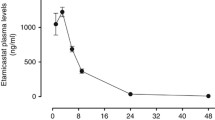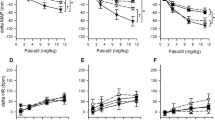Summary
In order to investigate whether vascular alpha-1 adrenoceptor antagonism plays a role in the antihypertensive effect of verapamil, tiapamil, and nifedipine, we studied their potencies to inhibit K+-induced45Ca2+ influx in rat isolated aorta and [3H]prazosin binding in rat brain membranes in vitro as well as their antihypertensive effect and functional alpha-1 adrenoceptor blockade in conscious spontaneously hypertensive rats (SHR) in vivo. Tiapamil proved 70 times less potent than verapamil in inhibiting calcium influx, but was equipotent in displacing [3H]prazosin. Nifedipine proved 10 times more potent than verapamil as calcium channel blocker but displayed negligible affinity for alpha-1 adrenoceptors in vitro. In conscious SHR, the three calcium channel blockers dose-dependently reduced mean arterial pressure after oral administration. Only at maximal antihypertensive doses, the increases in diastolic pressure to intravenous injection of the selective alpha-1 adrenoceptor agonist cirazoline were temporarily suppressed by nifedipine, verapamil, and tiapamil. No relationship existed between the relative potencies as calcium channel blocker and affinities for alpha-1 adrenoceptor binding sites in vitro with functional vascular alpha-1 adrenoceptor blockade in vivo. The data do not support the hypothesis that vascular alpha-1 adrenoceptor blockade plays a significant role in the antihypertensive effect of verapamil and related calcium channel blockers.
Similar content being viewed by others
References
Fleckenstein A, Frey M, Fleckenstein-Grun G. Antihypertensive and arterial anticalcinotic effects of calcium antagonists.Am J Cardiol 1986;57:1D-11D.
Frishman WH, Charlap S, Kimmel B, Goldberger J, Phillipiodes G, Klein N. Calcium-channel blockers for combined angina pectoris and systemic hypertension.Am J Cardiol 1986;57:22D-30D.
Müller B, Bolli P, Erne P, Kiowski W, Buhler FR. Calcium antagonism — A new concept for treating essential hypertension.Am J Cardiol 1986;57:50D-54D.
Fleckenstein A. Specific pharmacology of calcium in myocardium, cardiac pacemaker and vascular smooth muscle.An Rev Pharmacol Toxicol 1977;17:149–166.
Vanhoutte PM. Calcium entry blockers, vascular smooth muscle and systemic hypertension.Am J Cardiol 1985, 55:17B-23B.
Timmermans PBMWM, Thoolen MJMC, De Jonge A, Wilffert B, Van Zwieten PA. Calcium entry and alphaadrenoceptor induced vasoconstriction in vivo and in vitro. In: Refsum H, Mjos OD, eds.Alpha adrenoceptor blockers in cardiovascular disease. London, New York: Churchill Livingstone, 1985.pp. 30–50.
Timmermans PBMWM, Thoolen MJMC. Calcium utilization in signal transformation of alpha-1 adrenoceptors. In: Ruffolo RR, ed.Alpha-1 adrenoceptors. Humana Press, 1987, in press.
Cauvin C, Loutzenhiser R, Van Breemen C. Mechanisms of calcium antagonist-induced vasodilation.Ann Rev Pharmacol Toxicol 1983;23:373–396.
Motulsky J, Snivel MD, Hughes RJ, Insel PA. Interaction of verapamil and other calcium channel blockers with alpha-1 and alpha-2 adrenoceptors.Circ Res 1983;52:226–231.
Maisel AS, Motulsky J, Insel PA. Hypotension after quinidine plus verapamil. Possible additive competition at alpha-adrenergic receptors.New Eng J Med 1985;312:167–172.
Van Meel JCA, De Jonge A, Timmermans PBMWM, Van Zwieten PA. Selectivity of some alpha-adrenoceptor agonists for peripheral alpha-1 and alpha-2 adrenoceptors in the normotensive rat.J Pharm Exp Ther 1981;219:760–767.
Eigenmann R, Blaber L, Nakamura K, Thorens S, Haeusler G. Tiapamil, a new calcium antagonist.Drug Res 1981;31:1393–1401.
U.S. Department of Health and Human Services.Guide for the care and use of laboratory animals. NIH publication, 1985, pp. 85–23:1–83.
Chiu AT, McCall DE, Timmermans PBMWM. Pharmacological characteristics of receptor-operated and potential-operated Ca2+ channels in rats aorta.Eur J Pharmacol 1986;127:l-8.
Greenberg DA, U'Prichard DC, Snyder SH. Alpha-noradrenergic ceptor binding in mammalian brain: Differential labeling of agonist and antagonist states.Life Sci 1876;19:69–76.
U'Prichard DC, Greenberg DA, Snyder SH. Binding characteristics of a radiolabeled agonist and antagonist at central nervous system alpha-noradrenergic receptors.Mol Pharmacol 1977;13:454–473.
Lowry DH, Rosebrough NJ, Farr AL, Randall RJ. Protein measurement with the Folin phenol reagent.J Biol Chem 1951;193:265–275.
Van Meel JCA, De Jonge A, Kalkman HO, Wilffert B, Timmermans PBMWM, Van Zwieten PA. Organic and inorganic calcium antagonists reduce vasoconstriction in vivo mediated by postsynaptic alpha-2 adrenoceptors.Naunyn-Schmiedeberg's Arch Pharmacol 1981;316:288–293.
Naylor WG, Thompson JE, Jarrott B. The interaction of calcium antagonists (slow channel blockers) with myocardial alpha adrenoceptors.J Mol Cell Cardiol 1982;14:185–188.
Qian JQ, Mathy MJ, Thoolen MJMC, Timmermans PBMWM, Van Zwieten PA. Antihypertensive activity and interaction with alpha-adrenoceptors of tibalosine([1-2,3-dihydro-5-benzo-(b)-thienyl)-2-(4-phenyl-butylamino)-1-propanol], CP 804 S) in rat and cat preparations.Arch Int Pharmacodyn Ther 1983;266:264–281.
Van Zwieten PA, De Jonge A, Wilffert B, Timmermans PBMWM, Thoolen MJMC. Cardiovascular effects and interaction with adrenergic receptors of urapidil in rat and cat preparation.Arch Int Pharmacodyn Ther 1985;276:180–201.
Ruffolo RR, Morgan EL, Mesick K. Possible relationship between receptor reserve and the differential antagonism of alpha-1 and alpha-2 adrenoceptor mediated pressor responses by calcium channel antagonists in the pithed rat.J Pharmacol Exp Ther 1984;230:587–594.
Cavero I, Shepperson NB, Lefevre-Borg F, Langer SZ. Differential inhibition of vascular smooth muscle responses to alpha-1 and alpha-2 adrenoceptor agonists by diltiazem and verapamil.Circ Res 1983;52 (Suppl 1):69–76.
Bou J, Massingham R. Phenoxybenzamine-induced inhibition of cirazoline pressor responses in pithed rats pretreated with organic or inorganic calcium entry blocking drugs.Eur Pharmacol 1984;102:535–539.
Gross F. Drugs acting on arteriolar smooth muscle (Vasodilator drugs). In: Gross F. ed.Handbook of experimental pharmacology 39, Berlin, Heidelberg, New York: Springer Verlag, 1977. pp. 452–457.
Gerold M, Eigenmann R, Haeusler G. Cardiovascular effects of tiapamil (Ro 11-1781), a new calcium entry blocker.J Cardiouasc Pharmacol 1982;4:419–429.
Balansard P, Elkik F, Levenson JA, Ciampi M, Sans P. Effect of a new calcium antagonist, tiapamil, in hypertension of the elderly.Br J Clin Pharmacol 1984;18:823–830.
Author information
Authors and Affiliations
Rights and permissions
About this article
Cite this article
Thoolen, M.J.M.C., Miller, C.R., Chiu, A.T. et al. Effect of calcium entry blockers on blood pressure and vasoconstrictor responses to alpha-1 adrenoceptor stimulation in conscious spontaneously hypertensive rats. Cardiovasc Drug Ther 1, 377–383 (1987). https://doi.org/10.1007/BF02209079
Issue Date:
DOI: https://doi.org/10.1007/BF02209079




